Child poverty strategy: annual report, 2016
The third annual report on the Child Poverty Strategy for Scotland, which was published in March 2014.
5. Places: Children From Low Income Households Live In Well-Designed Sustainable Places
This chapter presents data for the indicators associated with the four intermediate outcomes highlighted below:
Figure 5.1: Logic model for 'Places' outcome
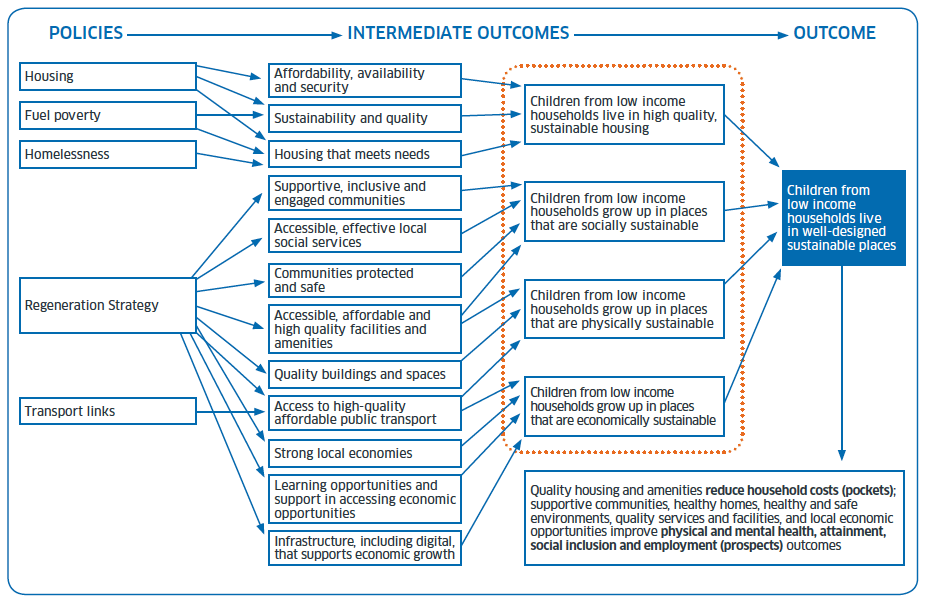
Table 5.1 summarises how the baseline figures published in the 2014 annual report compare to the most recent figures for each indicator (usually from 2015 or 2014 - more detail on the dates and sources of data for each indicator are provided in the Annex). The assessment of performance is based on the following:
⬆ performance improving - a statistically significant change in the desired direction
⬇ performance worsening - a statistically significant change in the opposite direction
⬌ performance maintaining - no statistically significant change
Table 5.1: Summary of performance against the 'places' indicators
| Indicator | 2014 report baseline | Most recent | |
| Average percentage of income spent on housing | 9.8% | 9.1% | ⬌ |
| Percentage of households in the most deprived areas satisfied with condition of home | 69% | 71% | ⬌ |
| Percentage of adults in the most deprived areas who feel they can influence decisions | 21% | 24% | ⬌ |
| Percentage of children from the most deprived areas who agree that people in their area talk to each other on the street |
63.8% | 64.0% | ⬌ |
| Percentage of adults in the most deprived areas who have been the victim of crime in the past year | 21.3% | 21.2% | ⬌ |
| Percentage of adults in the most deprived areas who say drug misuse is common in their neighbourhood | 34% | 27% | ⬆ |
| Percentage of adults in the most deprived areas saying their neighbourhood is a good place to live | 80% | 84% | ⬌ |
| Percentage of households in the most deprived areas satisfied with quality of local public transport | 76% | 80% | ⬌ |
| Percentage of adults in the most deprived areas who are within a five-minute walk of green space | 60% | 59% | ⬌ |
| Gap in the employment rate between the most deprived areas and the rest of Scotland | 19.5 percentage points | 16.0 percentage points | ⬆ |
| Gap in percentage of adults with low or no qualifications between the most deprived areas and the rest of Scotland |
15.8 percentage points | 14.2 percentage points | ⬌ |
| Gap in personal internet use between the most deprived areas and the rest of Scotland | 12 percentage points | 12 percentage points | ⬌ |
The rest of this chapter considers each of the indicators in turn, looking at the longer-term trends and any additional data that helps put these into context. The baseline and most recent data points are highlighted in the charts.
The indicators under the 'Places' outcome are intended as measures of the characteristics of the areas in which children grow up, rather than the characteristics of the children or their families themselves. Findings are therefore presented for the 15% most deprived Scottish Index of Multiple Deprivation ( SIMD) areas as a whole, and do not focus only on households with children.
Intermediate outcome 9: Children from low income households live in high quality, sustainable housing
Indicator 9.1 Average percentage of income spent on housing
This is a measure of the affordability of housing [11] . In 2014/15, households in Scotland spent on average 9.1% of their combined post-tax income on housing, compared to 9.8% in the baseline year (2011/12).
The overall trend since 2007 is that housing has become more affordable. This is due to incomes increasing at a slightly greater rate than housing costs.
⬌ Performance maintaining
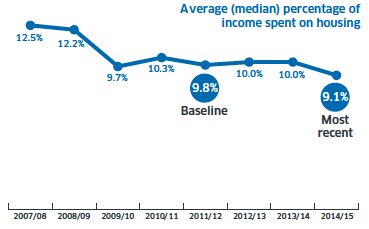
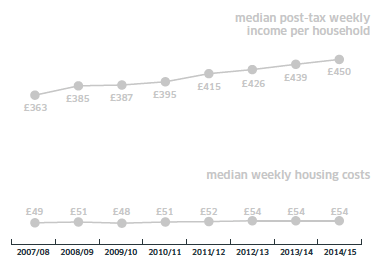
Indicator 9.2 Percentage of households in 15% most deprived SIMD datazones satisfied with condition of home
This is a proxy for housing quality. In 2014, 71% of households in the 15% most deprived SIMD datazones were satisfied with the condition of their home, compared to 69% of those in the 15% most deprived datazones in the baseline year (2012). This indicator has fluctuated over time, with a low of 69% in 2007 and 2012, and a high of 76% in 2009.
Satisfaction with the condition of their home has been consistently lower among households in the 10% most deprived areas than those in the rest of Scotland.
⬌ Performance maintaining
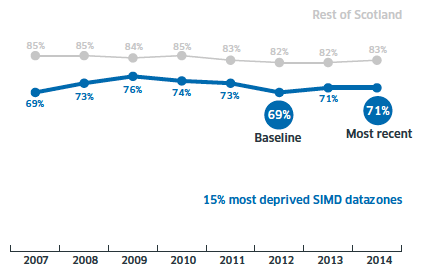
Intermediate outcome 10: Children from low income households grow up in places that are socially sustainable
This outcome is in line with the Scottish Government's focus on increasing openness and engagement, involving local communities in decision making. The indicators under this outcome focus on community engagement, interaction and safety.
Indicator 10.1 Percentage of adults in 15% most deprived SIMD datazones who agree they can influence decisions affecting their local area
This is a measure of one aspect of engaged communities. In 2015, 24% of adults in the 15% most deprived SIMD datazones agreed that they could influence decisions affecting their local area, compared to 21% in the baseline year (2012). The analysis excludes those who expressed no opinion. There has been an increase in the percentage agreeing that they can influence decisions since 2007.
A similar trend is evident among households in the rest of Scotland.
⬌ Performance maintaining
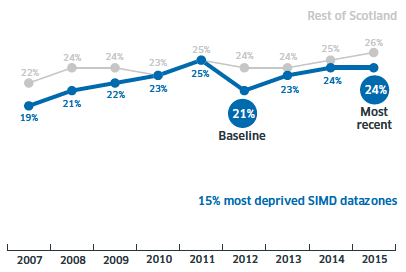
Indicator 10.2 Percentage of 13 and 15 years olds from 15% most deprived SIMD datazones who agree that people in their area say hello and talk to each other on the street
This indicator looks at community interaction and supportiveness from the perspective of children. There has been no new data on this indicator since the 2015 annual report, and the performance assessment and figures are therefore the same as reported previously.
In 2014, 64.0% of 13 and 15 year olds living in the 15% most deprived SIMD datazones [12] agreed that people in their area say hello and talk to each other in the street, compared to 63.8% in the baseline year (2010).
The percentage agreeing that people in their area say hello and talk to each other in the street has been consistently lower among households in the 15% most deprived areas than those in the rest of Scotland.
⬌ Performance maintaining
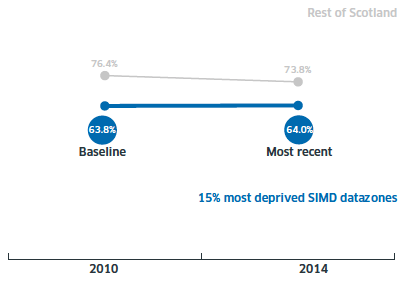
Indicator 10.3 Percentage of adults in 15% most deprived SIMD datazones who have been the victim of one or more crimes in the past year
In 2014-15, 21.2% of adults in the 15% most deprived SIMD datazones were victims of one or more crimes, compared to 21.3% in the baseline year (2012-13). This was lower than in 2008-09 and 2009-10.
Crime victimisation has been consistently higher among households in the 15% most deprived areas than those in the rest of Scotland. Since 2010-11, there has been no change to victimisation rates in the most deprived areas, but there has been a significant decrease in victimisation in the rest of Scotland.
⬌ Performance maintaining
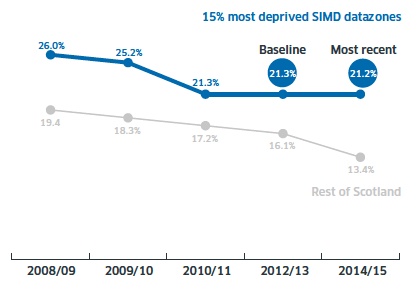
Indicator 10.4 Percentage of adults in 15% most deprived SIMD datazones who say drug misuse or dealing is common in their neighbourhood
This is a measure of anti-social behaviour. In 2015, 27% of adults in the 15% most deprived areas said drug misuse or dealing was common in their neighbourhood, compared to 34% in the baseline year (2012). There have been fairly substantial fluctuations between years, but a slight downward trend over time from 31% in 2007 to 27% in 2015.
Among adults in the rest of Scotland, the proportion who say that drug misuse is common in their area is much lower and has remained stable over time.
⬆ Performance improving
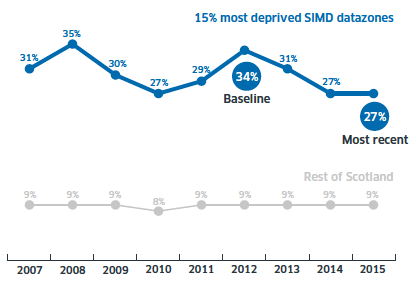
Intermediate outcome 11: Children from low income households grow up in places that are physically sustainable
This outcome reflects the importance of the natural and built environment in influencing quality of life and wellbeing.
Indicator 11.1 Percentage of adults in 15% most deprived SIMD datazones who say their neighbourhood is a good place to live
This is a general proxy for place quality. In 2015, 84% of adults from the 15% most deprived SIMD datazones thought that their neighbourhood was a good place to live, compared to 80% in the baseline year (2012). Perceptions have gradually improved over time.
Among the rest of Scotland, ratings of neighbourhoods have been consistently high over time.
⬌ Performance maintaining
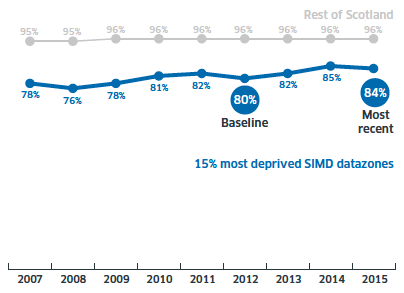
Indicator 11.2 Percentage of households in 15% most deprived SIMD datazones satisfied with quality of local public transport
Public transport is a key public service, which also has an important influence on the economic sustainability outcome through improving physical access to employment opportunities in other areas.
In 2015, 80% of adults in the 15% most deprived SIMD datazones were satisfied with the quality of local public transport, compared to 76% in the baseline year (2012). This indicator shows little change over time.
Satisfaction with public transport has been consistently higher among adults in the most deprived areas compared to adults in the rest of Scotland.
⬌ Performance maintaining

Indicator 11.3 Percentage of adults in 15% most deprived SIMD datazones who can access green space within a five-minute walk or less
This measures one aspect of the environmental quality of public spaces. In 2015, 59% of adults in the 15% most deprived SIMD datazones could access green space within a 5 minute walk, compared to 60% in the baseline year (2013) [13] .
The percentage of adults who can access greenspace has been consistently lower in the most deprived areas compared to the rest of Scotland.
⬌ Performance maintaining
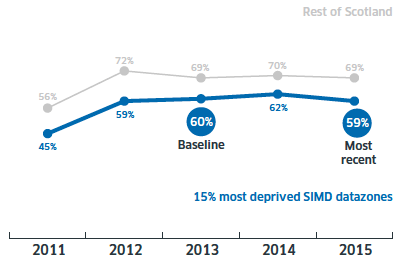
Intermediate outcome 12: Children from low income households grow up in places that are economically sustainable
The final intermediate outcome under the Places outcome is ' children from low income households grow up in places that are economically sustainable'. The indicators under this intermediate outcome measure inequality between areas by looking at the gap between the outcomes of all adults living in the 15% most deprived SIMD datazones and the outcomes for people in the rest of Scotland.
Indicator 12.1 Gap in employment rate between 15% most deprived and rest of Scotland
In 2015, the gap between the 15% most deprived SIMD datazones and the rest of Scotland was 16.0 percentage points, between 59.2% in the most deprived SIMD datazones and 75.2% elsewhere. This compares to 19.5 percentage points in the baseline year (2012) (between 53.8% in the most deprived SIMD datazones and 73.3% elsewhere). There have been fairly substantial fluctuations between years, but overall a slight downward trend between 2007 and 2015.
⬆ Performance improving
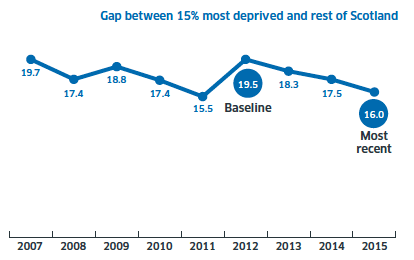
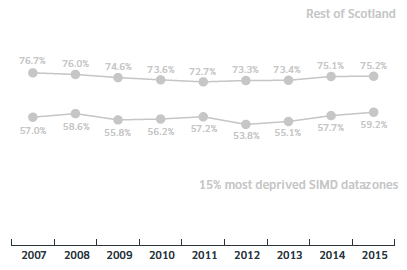
Indicator 12.2 Gap in percentage of adults with low or no qualifications between 15% most deprived SIMD datazones and rest of Scotland
In 2015, the gap between the most deprived SIMD datazones and the rest of Scotland was 14.2 percentage points, with 23.5% of people having low qualifications (at SCQF level 4 or below) or no qualifications in the 15% most deprived SIMD datazones, compared to 9.3% elsewhere. In the baseline year (2012), the gap was 15.8 percentage points (26.6% of people in the 15% most deprived SIMD datazones had low or no qualifications compared to 10.8% elsewhere).
The gap has gradually decreased over time, due to larger reductions in the percentage of adults with low or no qualifications in the 15% most deprived SIMD datazones than in the rest of Scotland.
⬌ Performance maintaining
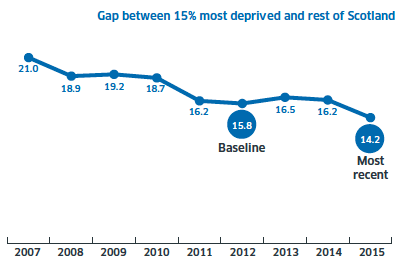
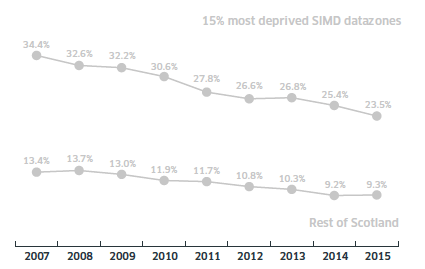
Indicator 12.3 Gap in personal internet use between 15% most deprived SIMD datazones and rest of Scotland
This is included as a proxy for digital infrastructure. In 2015, the gap was 12 percentage points, with 72% in the 15% most deprived areas using the internet for personal use, compared to 84% in the rest of Scotland. This gap is the same as in the baseline year (2012: 79% in the 15% most deprived areas using the internet for personal use, compared to 67% in the rest of Scotland).
The gap has decreased since 2007, despite an increase in the most recent year. This is due to larger increases in internet use in the 15% most deprived datazones (from 46% in 2007 to 72% in 2015) than in the rest of Scotland (from 65% in 2007 to 84% in 2015).
⬌ Performance maintaining
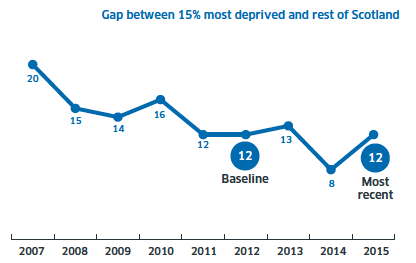
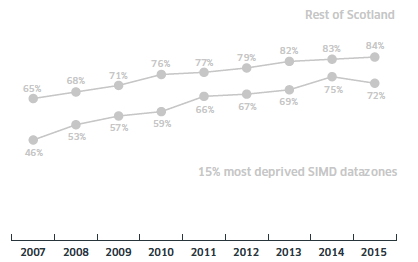
Contact
Email: Alison Stout
There is a problem
Thanks for your feedback